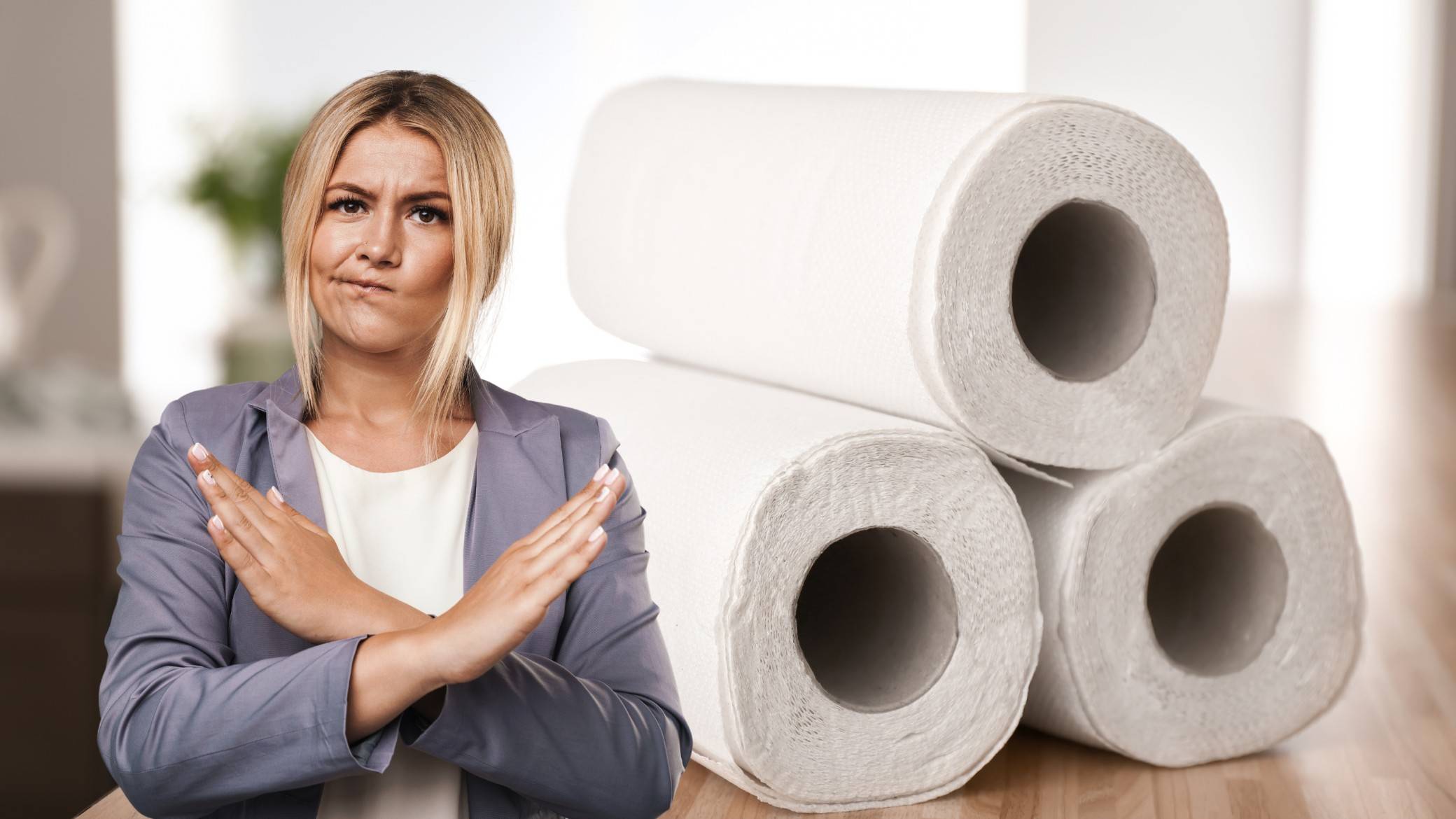Your child made a mess in the kitchen? Your pet left you a surprise on the floor? You’ve spilled wine? The first thing we reach for is paper towels. They’ve become an inseparable part of the kitchen. Americans use 270 million trees worth of paper towels a year.
Paper towels are single-use, chemically bleached, and we make them out of trees. Clearly, it’s time to find a more sustainable alternative.
I admit there was a time when I couldn’t imagine my kitchen without paper towels. But my waste went down by 20% since I stopped using them. I’ll explain exactly how I stopped using paper towels and give you excellent paper towel alternatives.
Are Paper Towels Sustainable?
No, paper towels aren’t sustainable. They’re hard to recycle, but you can compost them.
Here’s why you need to reconsider using paper towels.
Carbon Footprint
One paper towel roll production releases 0.06 lbs of CO2. This isn’t much.
But we can’t consider single sheets. Instead, consider the carbon footprint of paper towels through their entire life cycle. It starts with finding raw materials, manufacturing, packaging, distribution, and finally, use. Overall, the production of paper towels requires a lot of energy, which releases millions of metric tonnes of CO2.
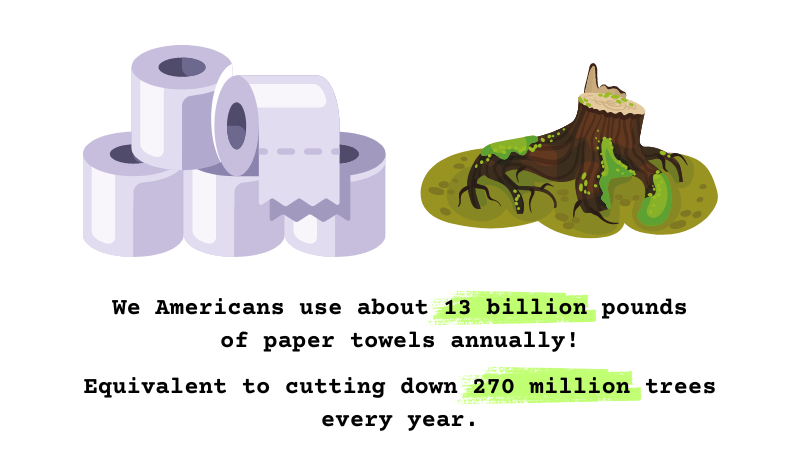
The Manufacturing
The manufacturing process of paper towels starts with virgin wood. Even if manufacturers use farmed trees instead of cutting down wild forests, it brings out a set of sustainability issues. Farmed trees are treated with unhealthy pesticides, herbicides, and fertilizers.
Then, the wood pulp is bleached. This means the manufacturers use chlorine, which is a toxic chemical. Some manufacturers even add formaldehyde and BPA for better wet strength and durability. All of these are carcinogenic and harmful to the environment.
Deforestation
It takes 17 trees and 20,000 gallons of water to make just one ton of paper towels. To offset the number of trees used to manufacture paper towels, we’d need to plant 51,000 trees a day.
An average user spends 80 rolls per year, which amounts to thousands in a person’s lifetime. This is the equivalent of an entire woodland. The loss of forests leads to habitat loss, endangered wildlife, high greenhouse gas emissions, and higher global temperatures.
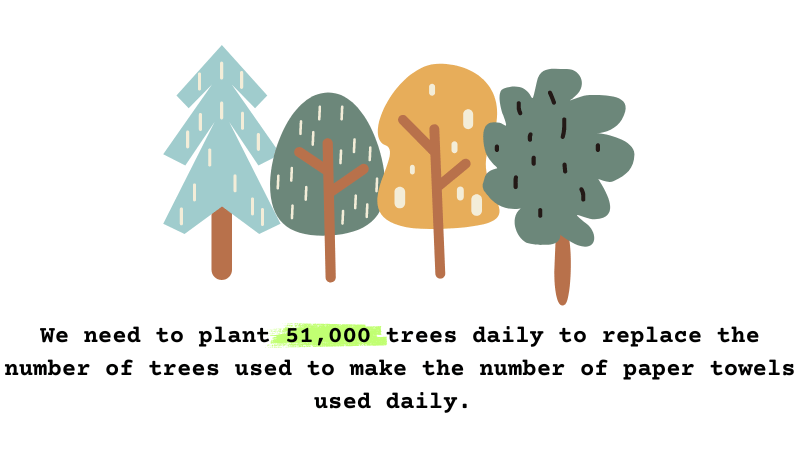
Paper Towel Waste
Global annual sales in 2017 were $12 billion, half of which was consumed by the US. In terms of quantity, this amounts to 13 billion pounds of paper towels used in the US per year.
So, where do those paper towels go? Paper towels are single-use, which means we use them once and toss them in the trash that goes to landfills. Landfill trash pollutes our oceans. Paper towels leave behind chemicals, bleaches, and plastic additives that go into the groundwater.
This is a big problem because paper towels account for the third largest proportion of municipal solid waste. There were over 17 million tonnes of paper towels in landfills in 2018.
Most concerningly, paper towels release methane as they decompose. Methane is a greenhouse gas that’s 28 more harmful than carbon dioxide.
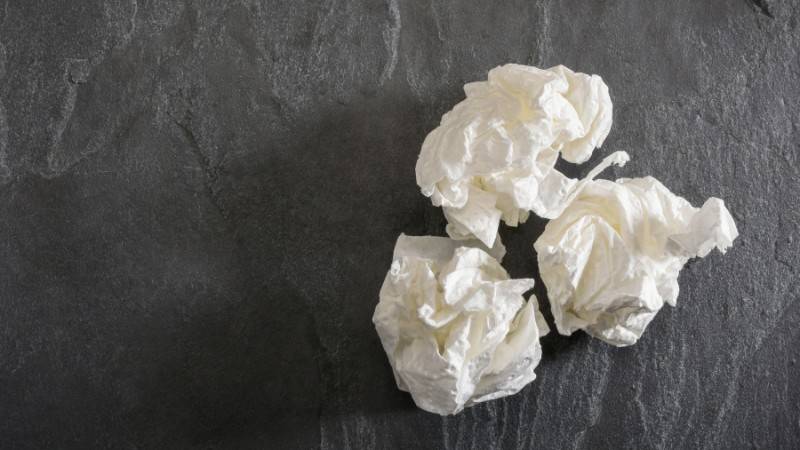
Can You Recycle Paper Towels?
No, you can’t recycle paper towels. There are two reasons why you can’t recycle paper towels: the contamination and the manufacturing process. Paper towels are processed in a way that completely changes the structure of the paper from which they started. Then, we use them in our homes, where they get soaked, broken down, and contaminated.
One study even found that using recycled paper towels isn’t much better for the environment. It saves trees but has the same environmental impact as virgin paper towels. Also, each time paper is recycled, its fibers get shorter, and after six iterations, they can’t bond into new paper. Considering paper towels rely on robust cellulose fibers, it means we can’t use them anymore.
Why You Can’t Recycle Paper Towels
You can’t recycle paper towels because recycling centers won’t accept materials contaminated with food grease or germs. This automatically excludes paper towels, given how people commonly use them.
Another reason is the manufacturing process. Paper towels start as a mixture of wood, cardboard, and paper by-products. All of these are beaten to a pulp, which weakens the natural fibers. The weakening of fibers makes it difficult to recycle paper towels later on.
Moreover, paper towels go through different chemical treatments. They are added toxic additives such as glue, resins, and others. These strengthen the paper towels and improve their texture and absorption. Finally, paper towels are treated with ink for bleach and coloring.
Even green paper towels, such as the unbleached brown ones, can’t be recycled. They are always contaminated by food or cleaning chemicals.
How To Stop Using Paper Towels (or Reduce)?
The best option to reduce paper towel usage is to stop using paper towels. But if you’re not ready to make this commitment yet, here are some ways to reduce paper towel usage. For example, if you’re cleaning with water or soap, let the paper towel dry and use it again.
You can also cut the paper towel into smaller pieces to extend the life of the roll.
A good idea is to go for brown towels, as these can be composted if you only use them for food. Also, use your paper towels with non-toxic cleansers and plant-based sprays, as these allow for composting.
Here’s how to use fewer paper towels according to the rooms in the home they are most commonly used.
In the Bathroom
Replace paper towels in your bathroom at home or place of business with clean, folded cloth towels. Or, install a hot air dryer (this works especially well at a business).
Also, make sure to shake your hands clean before using a towel. This minimizes the amount of moisture the towel has to absorb.
Another thing you can do is pat your hands dry on your pants or shirt. Your hands will dry quickly this way. You can carry a handkerchief in your purse or pocket and dry your hands when you’re out and about.
Finally, use rags for cleaning. Keep clean folded rags in the kitchen, so it’s always easy to get to them. You can wipe, scrub, or wash with cloth rags. They are very absorbent, so it’s great even if you have to pick up solids. You can wash the rag and use it again.
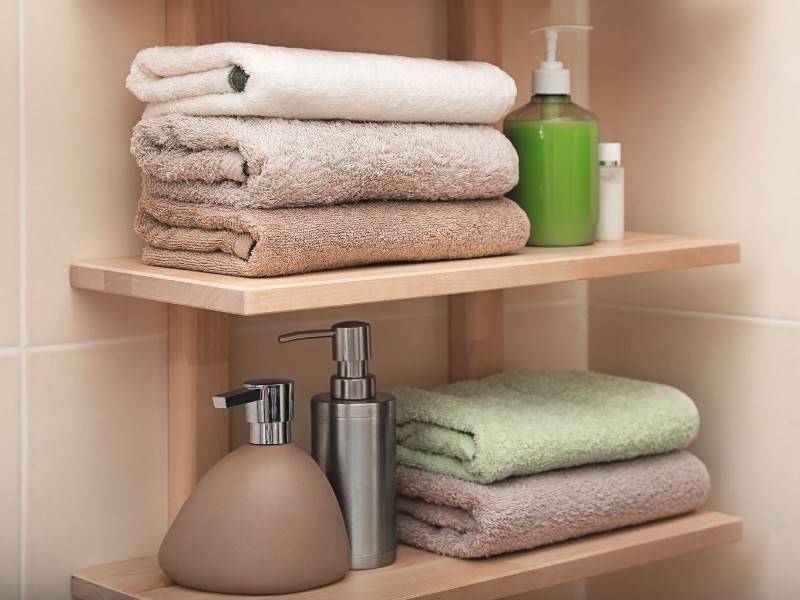
I cut old shirts I haven’t worn in years and turned them into rags. This is an affordable and environmentally friendly way to lower paper towel usage.
In the Kitchen
I used to dry frying foods on a paper towel to remove excess grease. However, you can do this on a rack set over a baking sheet. This is much more effective in draining the food than if you let it sit in a soaked paper towel. Another option for draining food is to use old newspapers.
If you use paper towels to clean your kitchen, substitute them with dishcloths and tea towels. Use tea towels for spills and dishcloths for anything that requires multiple rinses or soap.
Overall, the most important thing is accessibility. Give yourself options. If you have cloths, tea towels, or napkins in your kitchen, you’re much more likely to reach for them instead of paper towels.
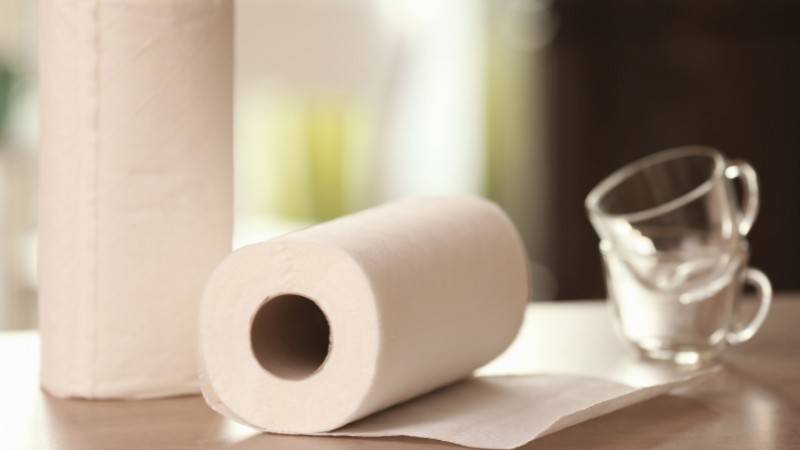
If you aren’t ready to stop using paper towels, tuck them away, for example, in a high cupboard or pantry. This way, it’s not in your line of sight, and you’ll be more tempted to use other items for cleaning.
During Travels
You can also use paper towel alternatives during travels. For example, start carrying a cloth napkin or a handkerchief for wiping your hands after using the bathroom or after meals. You can use a water bottle to wet the cloth if needed. This also means you don’t need to use wet wipes.
It may seem like a big change from what you’re used to, but once you start, you’ll see how easy it is.
What Are Some Good Paper Towel Alternatives?
If you’re wondering how to save on paper towels or how to stop using paper towels, the answer is paper towel alternatives.
Paper towel alternatives come in different shapes and sizes and can be made from recycled or sustainable materials, such as cotton, viscose, and cellulose. Most of them are biodegradable or compostable. Also, paper towel alternatives fall into two categories: those that are absorbent right away and those that need to be wet and wrung out.
Here’s a very kind of paper towel alternative you can go for.
1. Newspapers
If you’re old school and like to read physical newspapers in the morning, keep a stash of them, as they can double as a cleaning tool. Newspapers are especially good for cleaning glass surfaces and mirrors. They are better than paper towels as they produce a streak-free shine and easily remove streaks and spots off glass surfaces.
2. Microfiber Cloths
Microfiber is an environmentally friendly option because these clothes can be used again and again. Microfiber is soft to the touch and gently cleans surfaces, especially porcelain. This makes it great for cleaning sinks and toilets.
Plus, you can reuse these clothes. Just pop them in the washing machine, and they are ready to clean again.
3. Cloth Towels and Napkins
Cloth towels and napkins are great at meal times and for cleaning. Cloth towels come in indefinite options. You can choose between different shapes, sizes, and colors. You can get some with colorful prints that add a pop to your kitchen.
Choose cloth towels and napkins made of cotton, hemp, or bamboo. These can be used for years and withstand multiple cleanings and rinses. Plus, they dry easily. You need to launder them, so use non-toxic soap for the best results.
Also, you can turn old, ratty T-shirts into clothes and save money. If you decide to buy new ones, look for linen or organic cotton. They grab onto germs and release only when you rinse and wring with water.
4. Cloth Diapers
If your children progressed to the potty training stage, congrats and good luck! Now is the time to use their cloth diapers around the house.
Cloth diapers have a thick, liquid-absorbing construction, making them great for cleaning up big messes. You can also use them for dusting and mopping.
5. Reusable Wax Wraps
Reusable wax wraps are made from sustainable beeswax and organic cotton, which makes them a great eco-friendly option. They are waterproof and durable, and you can clean them with soap and warm water.
You can use reusable wax wraps to store and transport food. For example, pack them in your child’s lunchbox.
6. Sponges
Natural cellulose or bamboo sponges are non-plastic. One sponge can replace up to 30 paper towel rolls. Considering one roll has 100 sheets, this is one sponge for 3,000 paper towels. Not to mention how incredibly absorbent they are.
7. Reusable Paper Towels
Reusable paper towels go by different names: unpaper towels or paperless towels. They are made from cotton, cellulose, bamboo, and sugarcane using a technique that combines the convenience of paper towels with a lower environmental impact.
These towels look like a real roll of paper towels but are actually a set of cloths snapped together and stored on a paper towel holder. You can use them to wipe up spills and clean your home. Then, wash and reuse them. All you need to do is snap the clothes back together.
I personally prefer bamboo ones. This is a sustainable paper source that many paper products are switching to. Bamboo reusable paper towels are made from strong bamboo fibers that are super absorbent. Most importantly, these are tree-free paper towels that can be used for up to a week. If you’re looking to lower the environmental impact of paper towel use, this is one of the best options you can go for.
8. Reusable Bags
If you like to use paper towels to wrap and store leftovers, switch to sandwiches or snack bags. You can also go for linen bags and linen and cotton bowl covers. These are easy to use, wash, and reuse. Plus, they’ll last a long time, and you’ll save money.
Should You Stop Using Paper Towels
Yes, paper towel uses are endless. But that doesn’t mean much when we realize the amount of waste they contribute to. Paper towels are single-use and contribute to 20% of total municipal waste. Our landfills are running out of space, so lowering the number of paper towels we use can greatly help.
There are endless paper towel alternatives you can go for — everything from dishcloths, newspapers, old T-shirts, napkins, sponges, reusable paper towels, and many more. These can be used for different purposes. Check them out, find the alternatives that work best for you, and say goodbye to paper towels.
